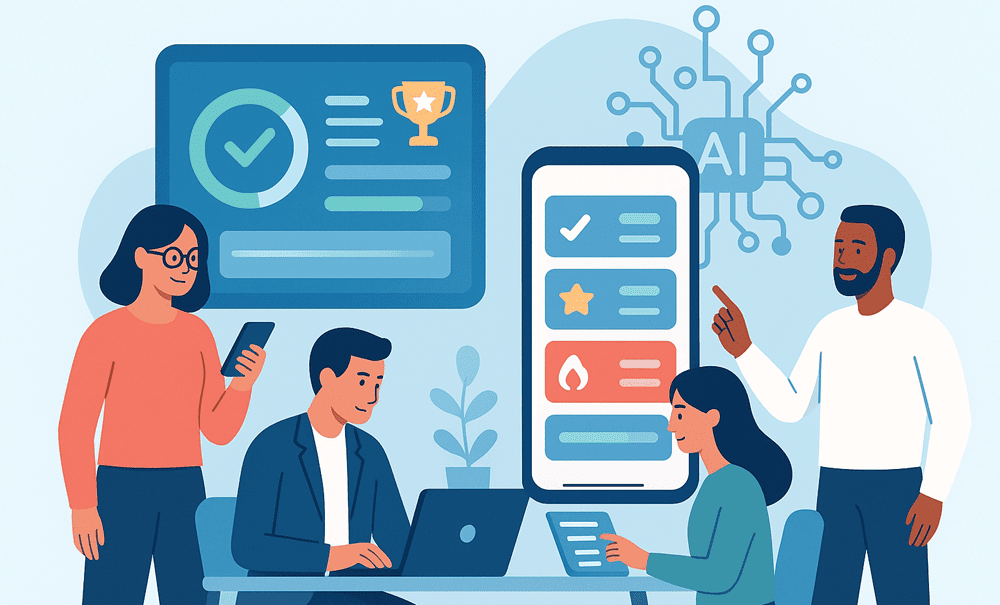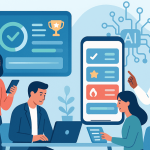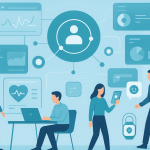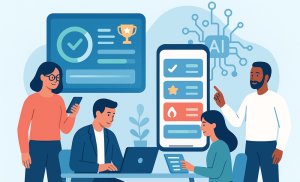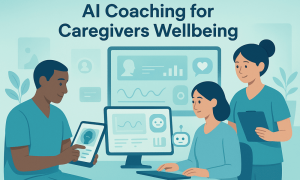Employee well-being programs often start strong but lose steam quickly. Many corporate leaders say the same thing: participation drops, employees forget the routine, and HR teams struggle to show real results. That’s where gamified AI workplace wellbeing comes in—turning healthy routines into something employees want to return to.
Today’s workplaces are shifting from traditional “wellness once a year” activities to ongoing, personalized, and interactive systems. With AI, games, and behavioral nudges mixed together, companies can finally build habits that stick, measure progress, and create a culture where employees feel supported rather than pressured.
This guide breaks down how AI-backed gamification works, why it boosts participation, and how organizations can measure success without micromanaging teams.
Why Gamification Matters in Workplace Well-Being
Gamification uses design elements like points, streaks, rewards, and challenges to make wellness routines feel less like a task and more like a personal mission. When done with AI, it becomes even more effective—because every activity, challenge, and reminder adapts to the employee’s preferences and behavior patterns.
What Companies See with Gamified Wellness Programs:
- Higher participation in wellbeing activities
- More consistent engagement over months
- A noticeable lift in motivation during stressful work periods
- Better insight into team wellbeing without manual tracking
Studies show that teams exposed to a gamified wellness platform see up to 60% higher engagement compared to traditional wellness modules. For busy teams, it’s much easier to stay involved when the system feels interactive and rewards progress instantly.
How AI Enhances Workplace Gamification
AI doesn’t just track steps or send generic reminders. It learns individual behaviors, predicts drop-off points, and designs wellness experiences that feel right for each employee.
1. Personalized Challenges for Habit Building
Everyone builds habits differently. AI looks at patterns—such as daily routines, preferred challenge types, or times when an employee is most active—and suggests customized tasks. This makes habit-building tech more approachable and less overwhelming.
For example:
- An employee working evening shifts may receive nighttime mindfulness prompts.
- A team member with high screen time gets digital detox challenges.
- Someone who prefers short activities receives micro-habits rather than long modules.
In a paragraph like this, we can naturally include habit-building tech, and ensure only one internal link keyword appears later when needed.
2. Real-Time Employee Engagement Metrics
For corporate leaders and HR teams, tracking engagement manually is nearly impossible. AI turns this into an automated, visual, and meaningful process.
Companies can now track:
- Participation rates
- Completion streaks
- Team challenge performance
- Drop-off triggers
- Impact on mood and stress indicators
This data ties directly into employee engagement metrics, allowing HR to make smarter decisions and adjust programs without guessing.
3. Game Mechanics That Support Emotional Well-Being
Gamification works best when combined with emotional check-ins and stress insights. AI systems can detect patterns and offer gentle nudges before stress becomes burnout.
In a paragraph like this, we may include one internal link keyword, such as AI emotional check-ins, while keeping the narrative natural.
AI-Driven Game Elements That Boost Well-Being
Below is a simple table showing gamified features and how AI strengthens them:
| AI Feature | How It Helps | Example Use Case |
| Personalized challenges | Builds sustainable routines | Daily movement goals adjusted to employee workload |
| Predictive nudges | Stops habit drop-off | Suggests micro-breaks during stressful periods |
| Points & streak tracking | Encourages consistency | Healthy habit streak celebrations |
| Leaderboards (optional) | Fosters friendly competition | Team “wellbeing week” challenges |
| Mood-based recommendations | Supports emotional health | Suggests breathing exercises on tough days |
By combining these with AI health gamification, the system supports employees without making them feel monitored.
Why Gamified AI Workplace Wellbeing Works for Corporate Teams
1. It Reduces Friction
Employees often skip wellness tasks because:
- They forget
- They feel too busy
- The tasks feel dull
- The activities feel generic
Gamified experiences solve this by offering micro-challenges, small rewards, and instant validation—things our brains naturally respond well to.
2. It Fits into Daily Work Easily
Gamification doesn’t require employees to spend long hours in training. Most activities are small:
- 2-minute breathing tasks
- 3-minute stretch alerts
- 10-minute focus sessions
- Short digital wellbeing challenges
This helps integrate well-being into the actual workday rather than outside of it. It’s an ideal fit for teams using digital wellbeing challenges.
3. It Makes Progress Visible (and Rewarding)
Employees don’t just want to participate—they want to see improvement. AI tools show:
- Weekly progress
- Habit streaks
- Awards collected
- Team contribution scores
These simple visual cues are powerful motivators, similar to how fitness apps maintain engagement.
A paragraph like this allows for natural placement of an internal link keyword such as AI wellbeing dashboards.
Building Sustainable Habits with AI Gamification
Gamification isn’t a one-time corporate activity—it’s a long-term strategy for building healthier employees.
What Sustainable Habit Formation Looks Like with AI:
- Start with small wins
Employees receive simple tasks like 1-minute reset exercises. - Consistent nudges
AI sends reminders based on an individual’s engagement pattern. - Reward loops
Every streak, badge, or milestone reinforces the behavior. - Adaptive challenges
If an employee loses momentum, AI shifts to easier goals to help them restart. - Emotional feedback integration
Mood or stress inputs shape future recommendations.
This approach supports long-term wellness, not just short bursts of activity.
Making Well-Being Fun for Your Organization
Gamification helps businesses maintain momentum across departments—especially in companies with diverse work cultures or hybrid teams.
Examples of Fun, Low-Effort Wellness Games:
- “7-Day Digital Reset Challenge”
- Team step-count races
- Stress-lower scoreboards
- Quiet hour competition for focused work
- Healthy break-time games
When paired with AI, these turn into ongoing experiences that adjust to employee needs. This is also where companies might integrate mindful prompts, connecting to internal link keywords such as AI mindfulness exercises.
How Corporate Leaders Benefit
Executives and HR teams don’t just get happier employees—they also get:
- Measurable productivity improvements
- Lower absentee rates
- Early indicators of team stress
- A system that runs on automation, not manual tracking
Leading organizations report up to 25% better participation within three months of adding gamified AI systems. The data helps inform strategy and adds clarity across wellness decisions.
A paragraph discussing leadership can naturally incorporate AI coaching for leaders.
Implementing Gamified AI Workplace Wellbeing: A Step-by-Step Blueprint
Here’s a simple approach for organizations looking to roll it out:
1. Start with a baseline
Track current participation levels and employee feedback.
2. Introduce small digital challenges
Begin with micro-habits and fun activities.
3. Connect AI tracking tools
Integrate emotion check-ins, stress insights, or progress dashboards.
4. Encourage friendly team participation
Build a culture of collaboration rather than competition.
5. Reward consistency, not perfection
This ensures long-term adherence.
6. Review engagement data
Measure progress through employee engagement metrics and adapt challenges accordingly.
7. Keep the experience fresh
AI helps rotate challenge formats and introduce new nudges over time.
The Future of Wellness Is Interactive and AI-Powered
Gamified wellness is no longer a trend—it’s becoming a standard practice for companies aiming to support both productivity and mental health. With gamified AI workplace wellbeing, organizations can build happier environments, establish healthier routines, and gain insights that were once impossible to collect manually.
It’s wellness that feels enjoyable, personalized, and sustainable.

